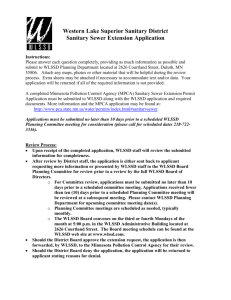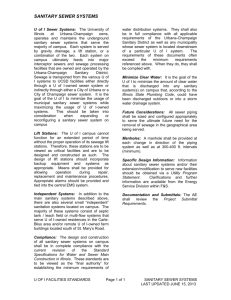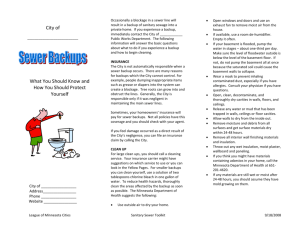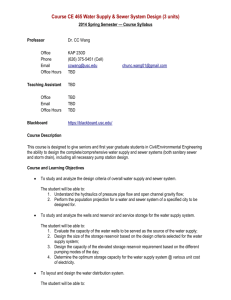Lawrie Road Catchment Area, Town of Ajax, Fall Newsletter
advertisement
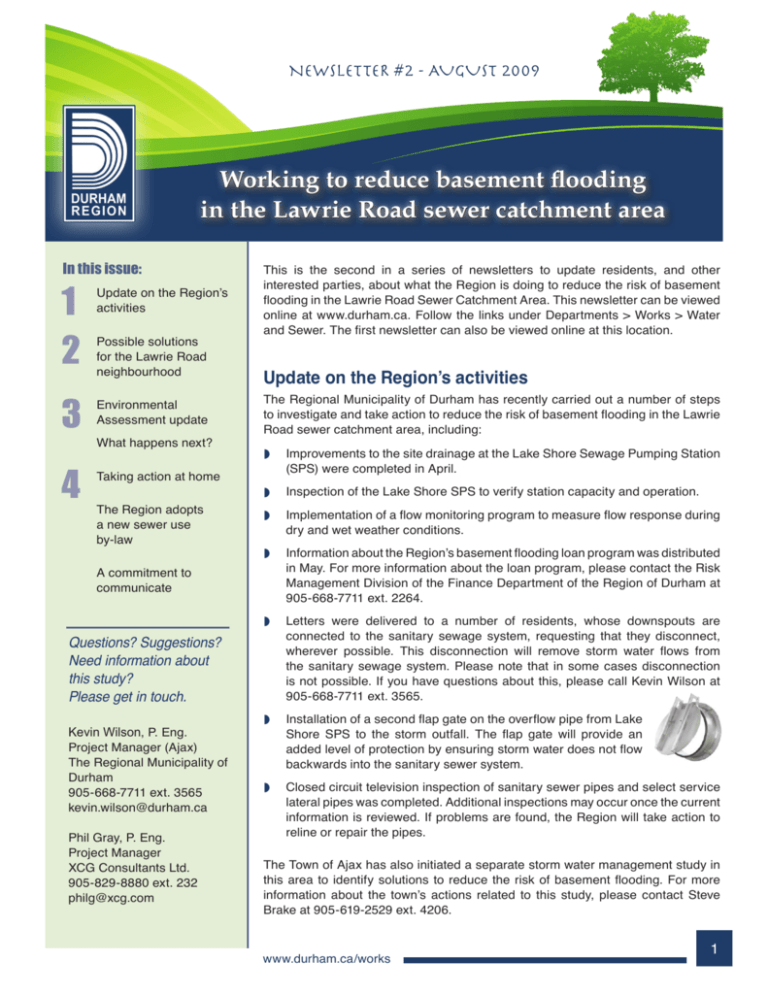
Newsletter #2 - August 2009 Working to reduce basement flooding in the Lawrie Road sewer catchment area In this issue: 1 2 3 4 Update on the Region’s activities Possible solutions for the Lawrie Road neighbourhood Environmental Assessment update What happens next? Taking action at home The Region adopts a new sewer use by-law A commitment to communicate Questions? Suggestions? Need information about this study? Please get in touch. Kevin Wilson, P. Eng. Project Manager (Ajax) The Regional Municipality of Durham 905-668-7711 ext. 3565 kevin.wilson@durham.ca Phil Gray, P. Eng. Project Manager XCG Consultants Ltd. 905-829-8880 ext. 232 philg@xcg.com This is the second in a series of newsletters to update residents, and other interested parties, about what the Region is doing to reduce the risk of basement flooding in the Lawrie Road Sewer Catchment Area. This newsletter can be viewed online at www.durham.ca. Follow the links under Departments > Works > Water and Sewer. The first newsletter can also be viewed online at this location. Update on the Region’s activities The Regional Municipality of Durham has recently carried out a number of steps to investigate and take action to reduce the risk of basement flooding in the Lawrie Road sewer catchment area, including: Improvements to the site drainage at the Lake Shore Sewage Pumping Station (SPS) were completed in April. Inspection of the Lake Shore SPS to verify station capacity and operation. Implementation of a flow monitoring program to measure flow response during dry and wet weather conditions. Information about the Region’s basement flooding loan program was distributed in May. For more information about the loan program, please contact the Risk Management Division of the Finance Department of the Region of Durham at 905-668-7711 ext. 2264. Letters were delivered to a number of residents, whose downspouts are connected to the sanitary sewage system, requesting that they disconnect, wherever possible. This disconnection will remove storm water flows from the sanitary sewage system. Please note that in some cases disconnection is not possible. If you have questions about this, please call Kevin Wilson at 905-668-7711 ext. 3565. Installation of a second flap gate on the overflow pipe from Lake Shore SPS to the storm outfall. The flap gate will provide an added level of protection by ensuring storm water does not flow backwards into the sanitary sewer system. Closed circuit television inspection of sanitary sewer pipes and select service lateral pipes was completed. Additional inspections may occur once the current information is reviewed. If problems are found, the Region will take action to reline or repair the pipes. The Town of Ajax has also initiated a separate storm water management study in this area to identify solutions to reduce the risk of basement flooding. For more information about the town’s actions related to this study, please contact Steve Brake at 905-619-2529 ext. 4206. www.durham.ca/works 1 Newsletter #2 - August 2009 Possible solutions for the Lawrie Road neighbourhood Now that most of the background information has been analyzed, and some flow information has been downloaded from the monitors, the team is starting to identify issues and potential solutions. For this area, possible issues include: Sanitary system capacity issues during wet weather. Presence of excessive inflow and infiltration in the sanitary system. In other words, groundwater (water found below the ground surface) could enter sewer pipes through cracks, pipe joints and other system leaks (infiltration). Or, surface water could directly enter the sanitary sewer system through manhole covers, connected downspouts and foundation drains, uncapped clean outs, and/or illegally cross-connected catchbasins (inflow). The potential of backwater conditions from the storm system at the Lake Shore SPS. To address these issues, some possible solutions are being considered. It is important to remember that this information is preliminary, and will be confirmed or discounted with detailed analysis and public input. Potential solutions include: 1. Neighbourhood source controls, such as disconnecting downspouts and foundation drains from the sanitary sewer system to reduce the flows. 2. New storage facilities to keep excess wastewater temporarily during and after a wet weather event. 3. Improvements to the Lake Shore SPS. 4. Modifications to the existing sanitary sewer system. www.durham.ca/works 2 Newsletter #2 - August 2009 Environmental Assessment update In the spring, the Region started an engineering study, under the province’s Class Environmental Assessment (EA) process (Schedule B), to identify remaining sanitary sewer system issues in the neighbourhood and develop plans about how best to reduce the risk of basement flooding. During the course of the EA, the study team has or will: Collect and review all available information. Studies conducted in the past are valuable data sources, along with additional information collected from residents, the town and the Region. Understand the interaction between the sanitary and storm water systems, and identify primary causes of flooding. Identify any additional early action control measures. Evaluate alternative control strategies to reduce the risk of basement flooding. Recommend solutions that will minimize the risk of basement flooding that are also environmentally sound and cost effective. The study team, led by XCG Consultants Limited, has placed a number of flow monitors at various locations in the neighbourhood. Between April and October, the monitors will provide information about where water is entering the system, the direction of the flows, and the reaction of the system. Information is being downloaded at regular intervals. This information will be analyzed and used to support the development of a system hydraulic model to evaluate the system under a variety of conditions and “what-if” scenarios. What happens next? The next step will be to use computer models as an information tool. First, the computer model will be set up to show the existing sanitary sewer system, including the type of pipes and flows. Then, the model will be tested to make sure it shows results that are like the ones experienced in the real world. Finally, the potential solutions can be introduced into the model to show the effects it would have on the sanitary sewer system. Each solution will also be reviewed against a number of factors, such as: How it affects the neighbourhood. How it affects the natural environment. Performance. Cost. How easy it is to build and maintain. These are called evaluation criteria, and they are an important and required part of any EA process. If you have any comments or ideas about these potential solutions, or how they will be evaluated, please get in touch with a member of the study team. Preliminary recommendations will be presented for community feedback at a public information centre this fall. www.durham.ca/works 3 Newsletter #2 - August 2009 Taking action at home While the Region does its work, homeowners can also take a number of steps to reduce the amount of water entering the sewer systems. Use water efficiently to reduce flows to sanitary sewer system: When replacing toilets and washing machines, choose low-flow, waterefficient models. Turn off the tap when brushing one’s teeth. Water your lawn wisely in the summer. It takes only 2.5 centimetres (one inch) of water, per week to maintain a healthy lawn. Wherever possible, disconnect downspouts from the sewer system. Manage your storm water at home: Consider soft-surface landscaping that allows storm water to soak into the ground. Plant a tree or rain garden to absorb storm water. If your downspouts are disconnected, consider using a rain barrel to capture water for use around your property. The Region adopts a new sewer use by-law In June 2009, revisions to the Region’s sewer use by-law were approved. These revisions mean that when building new homes, or additions to existing homes, connecting private and/or foundation drains to the sanitary sewer system is now prohibited. Removing these storm water flows from the sanitary sewer system ensures that more sewage treatment capacity is available, especially during heavy rain and snow melt. It also means that the sewage treatment plants and pumping stations can operate more efficiently and reduces the likelihood of causing sewage backups to basements and the environment. The revisions to the Sewer Use By-Law also permit the Region to disconnect existing foundation drains from the sanitary sewer if the associated flows adversely affect the operation of the sanitary sewer system. Although connecting downspouts, foundation and private drains to the sanitary sewer system was common practice prior to the 1980s, current best practices are to manage storm water on site by using sump pumps, or to connect to the storm sewer. A copy of the Region’s Homeowner Guide to Foundation Drain Connections is attached to this newsletter. A commitment to communicate Through the course of this study, residents can expect to receive updates as information becomes available. You can expect: A second public information centre to be held in the fall, to present and gain feedback on the study recommendations. A follow-up newsletter in the fall. Updates on the Region’s website at www. durham.ca Responses to your inquiries, questions and concerns throughout this study. If a response isn’t available right away, it will be provided as the information becomes available. www.durham.ca/works 4


